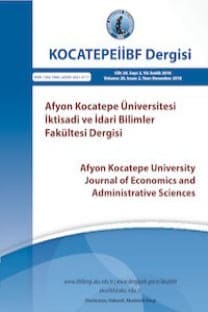BAŞLICA MAKROEKONOMİK GÖSTERGELERİN GELİŞMEKTE OLAN ÜLKELER TAHVİL ENDEKSİ ÜZERİNDEKİ ETKİSİ
Öz
This paper examines the effects of major macroeconomic fundamentals on emerging market bond index spreads by using a panel of 25 emerging market countries’ bond index spreads and a set of macroeconomic indicators between 2000 and 2009. The findings of the study suggest that there is a positive relationship between bond index spread and foreign direct investment, inflation and a negative relationship between bond index spread and GDP, reserve in total external debt. Major determinants of the emerging markets bond index are determined by using regression analysis based on ordinary least squares method has been applied consisting of fixed effect model, random effect model, but Hausman test showed that fixed effect model is more appropriate.
Anahtar Kelimeler:
Gelişmekte Olan Ülkeler, Gelişmekte Olan Ülkeler Tahvil Endeksi, Panel Data Analizi.
EFFECTS OF MAJOR MACROECONOMIC INDICATORS ON EMERGING MARKETS BOND INDEX
Keywords:
Emerging Markets, Emerging Markets Bond Index Spreads,
___
- BALDACCI, Emanuel, GUPTA, Sanjeev and MATI, Amine (2008) “Is It (Still) Mostly Fiscal? Determinants of Sovereign Spreads in Emerging Markets”, IMF Working Paper, No.08/259, Washington: International Monetary Fund, pp.1-23.
- BECK, Roland (2001) “Do Country Fundamentals Explain Emerging Market Bond Spreads?”, CFS Working Paper, No. 2001/02, Frankfurt: Center for Financial Studies, pp.1-32.
- BELLAS, Dimitri, PAPAIOANNOU, Michael G., and PETROVA, Iva (2010) “Determinants of Emerging Market Sovereign Bond Spreads: Fundamentals vs Financial Stress”, IMF Working Paper, No. 10/281, Washington: International Monetary Fund, pp.1-23.
- BENGOECHEA, Gonzalo G. (2012) “The Fallacy of Fundamentals: Determinants of Sovereign Bond Yields in the Eurozone”, (online), http://www.unioviedo.es/ forofinanzas/papers/F3D.The%20 Fallacy %20of%20Fundamentals_%20 Determinants%20of%20Sover_.pdf 07.04.2013, pp.1-23.
- BLANCHARD, Olivier (2004) “Fiscal Dominance and Inflation Targeting: Lessons From Brazil”, NBER Working Paper, No. 10389, pp.1- 35.
- CHEIKH A. Gueye, and SY, Amadou Nicolas Racine (2013) “U.S. Interest Rates and Emerging Market Bond Yield Spreads: A Changing Relationship?”, The Journal of Fixed Income, Vol. 22, No.4, pp. 48-52.
- COMELLI, Fabio (2012) “Emerging Market Sovereign Bond Spreads: Estimation and Back-testing”, IMF Working Paper, No.12/212, Washington: International Monetary Fund, pp.1-42.
- ÇULHA, Olcay Yücel, ÖZATAY, Fatih and ġAHINBEYOĞLU, Gülbin (2006) “The Determinants of Sovereign Spreads in Emerging Markets”, Research and Monetary Policy Department Working Paper, No:06/04, Ankara: The Central Bank of Turkey, pp.1-43.
- EDWARDS, S. (1984) “LDC’s Foreign Borrowing and Default Risk: An Empirical Investigation”, American Economic Review, Vol.74, No.4, pp.726-734.
- EICHENGREEN, Barry, and MODY, Ashoka (1998) “What Explains Changing Spreads on Emerging Market Debt: Fundamentals or Market Sentiment?”, NBER Working Paper, No:6408, Cambridge, Mass.: National Bureau of Economic Research, pp.1-45.
- FERRUCCI, Gianluigi (2003) “Empirical determinants of emerging market economies’ sovereign bond spreads”, Bank of England, Working Paper no. 205, pp.1-42.
- FINANCIAL TIMES LEXĠCON (2013) “Definition of EMBI”, (online), http://lexicon. ft.com/Term?term=EMBI, 12.03.2013. GUJARATI, Damodar N. (2002) Basic Econometrics, 6th Ed., New York: Macgraw Hill.
- JARAMILLO, Laura and TEJADA, C. Michelle (2011) “Sovereign Credit Ratings and Spreads in Emerging Markets: Does Investment Grade Matter?”, IMF Working Paper, WP/11/44, pp.1-17.
- MCCARTHY, Erin (2012) “Emerging-Market Dollar Debt Issuance Hits Record High in 2012”, (online), http://online.wsj.com/article/BT-CO- 20121231-704622.html, 10.04.2013.
- MIN, Hong-Ghi. G. (1998) “Determinants of Emerging Market Bond Spread: Do Economic Fundamentals Matter?”, Working Paper in International Economics, Trade, and Capital Flows, No. 1899, Washington: The World Bank, pp.1-31.
- NEUMEYER, P.A. and PERRI, Fabrizio (2005) “Business Cycles in Emerging Economies: The role of Interest Rates”, Journal of Monetary Economics, Vol.52, pp.345-380.
- NICKEL, Christane, ROTHER, Philipp C. and RÜLKE, Jan C. (2009) “Fiscal Variables and Bond Spreads – Evidence from Eastern European Countries and Turkey”, European Central Bank Working Paper, No. 1101, Frankfurt: European Central Bank, pp.1-43.
- ÖZATAY, Fatih, ÖZMEN, Erdal and ġAHINBEYOĞLU, Gülbin (2007) “Emerging Market Sovereign Spreads, Global Financial Conditions and U.S. Macroeconomic News”, Economic Research Center Working Papers in Economics, No: 07/07, Ankara: Middle East Technical University, pp.1-29.
- POGHOSYAN, Tigran (2012) “Long-Run and Short-Run Determinants of Sovereign Bond Yields in Advanced Economies”, IMF Working Paper, No:12/271, Washington: International Monetary Fund, pp.1-25.
- SIKLOS, Pierre L. (2011) “Emerging Market Yield Spreads: Domestic, External Determinants and Volatility Spillovers”, Global Finance Journal, Vol.22, No.2, pp.83-100.
- ISSN: 1302-1966
- Yayın Aralığı: Yılda 2 Sayı
- Başlangıç: 1999
- Yayıncı: Afyon Kocatepe Üniversitesi, İktisadi ve İdari Bilimler Fakültesi
Sayıdaki Diğer Makaleler
KÖYLERE HİZMET GÖTÜRME BİRLİKLERİNİN İŞLEVSELLİĞİ ÜZERİNE BİR ALAN ARAŞTIRMASI: BARTIN ÖRNEĞİ
FİNANSAL RASYOLARIN FİRMA DEĞERİNE ETKİSİ: BORSA İSTANBUL (BİST)’DA BİR UYGULAMA
Osman ULUYOL, , Veysel Eren TÜRK
GÜÇ MESAFESİ ÖRGÜTSEL GÜVENİ ETKİLER Mİ?
Bekir ELMAS, , Maysam AMANIANGANEH
Mustafa Abdül Metin DİNÇER, , Yasemin ÖZDEMİR
VESAYET DEMOKRASİSİ VE TÜRKİYE ÖRNEĞİ
KÜMELENME VE REKABETÇİLİK İLİŞKİSİ: KAVRAMSAL BİR İNCELEME
BELÇİKA, DANİMARKA, FİNLANDİYA VE HOLLANDA’NIN VERGİ HARCAMALARI GELİŞİMİ
GELIŞMIŞ VE GELİŞMEKTE OLAN ÜLKELERDE KAMU-ÖZEL ORTAKLIKLARI: BİRLEŞİK KRALLIK VE TÜRKİYE ÖRNEKLERİ
